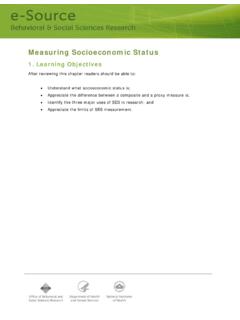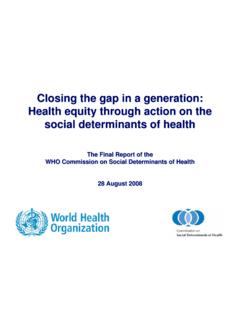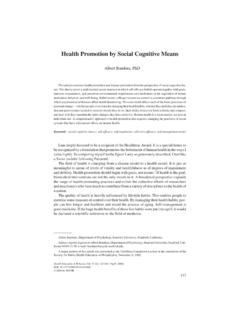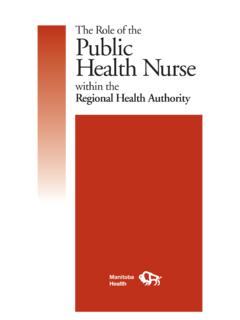Transcription of Social and Behavioral Theories - OBSSR e-Source
1 Social and Behavioral Theories 1. Learning Objectives After reviewing this chapter, readers should be able to: Define what theory is and identify two key types of Social and Behavioral science theory that are relevant to public health interventions. Desc ribe the key constructs of four Theories that are often used in public health interventions: the health Belief Model, The Transtheoretical Model and stages of change, Social Cognitive Theory, and the Social Ecological Model. Understand the nature of evidence about the relative effectiveness of theory-based interventions. Identify the most important considerations in choosing the right theory to address a health behavior problem in a particular population and context. 2. Introduction The most successful public health programs and initiatives are based on an understanding of health behaviors and the context in which they occur. Therefore, interventions to improve health behavior can be best designed with an understanding of relevant Theories of behavior change and the ability to use them skillfully.
2 The science and art of using health behavior Theories reflect an amalgamation of approaches, methods, and strategies from Social and health sciences. This broad range of perspectives from Social and Behavioral sciences are referred to Social and Behavioral science theory throughout this chapter. Influential work draws on the theoretical perspectives, research, and practice tools of such diverse disciplines as psychology, sociology, Social psychology, anthropology, communications, nursing, economics, and marketing. A growing body of evidence suggests that interventions developed with an explicit theoretical foundation or foundations are more effective than those lacking a theoretical base and that some strategies that combine multiple Theories and concepts have larger effects. 2. Introduction This chapter provides an overview of contemporary Social and Behavioral science theory use for development, implementation and evaluation of public health and health promotion interventions.
3 The following section defines theory and key types of theory in the context of the multiple determinants and multiple levels of determinants of health and health behavior. The sections after that describe important Theories and their key concepts, and summarize the evidence about the use of theory in health behavior intervention research. This is followed by a discussion of future directions and challenges for bridging the divides between theory, practice and research. 3. Theory and Why It is Important A theory presents a systematic way of understanding events, behaviors and/or situations. The notion of generality, or broad application, is important. Thus, Theories are by their nature abstract and not content- or topic-specific. Even though various theoretical models of health behavior may reflect the same general ideas, each theory employs a unique vocabulary to articulate the specific factors considered to be important.
4 Theories vary in the extent to which they have been conceptually developed and empirically tested; however, testability is an important feature of a theory. As Stephen Turner has noted in his chapter on Theory Development, Social science Theories are better understood as models that work in a limited range of settings, rather than laws of science which hold and apply universally. A theory is a set of interrelated concepts, definitions, and propositions that explains or predicts events or situations by specifying relations among variables. 3. Theory and Why It is Important Theories can guide the search to: Understand why people do or do not practice health promoting behaviors; Help identify what information is needed to design an effective intervention strategy; and Provide insight into how to design a program so it is successful. These two broad types of theory explanatory theory and change theory may have different emphases but are complementary.
5 For example, understanding why an employee smokes is one step toward a successful cessation effort, but even the best explanations won t be enough by themselves to fully guide change to improve health . Some type of change model will also be needed. All of the Theories and models described here have some potential as both explanatory and change models, though they might be better for one or the other purpose. For example, the health Belief Model was originally developed as an explanatory model, whereas in contrast the Stages of Change construct of The Transtheoretical Model was conceived to help guide planned change efforts. Theories and models help explain behavior, as well as suggest how to develop more effective ways to influence and change behavior. 3. Theory and Why It is Important Both explanatory Theories and change Theories are rooted in an understanding of the Social determinants of health and health behavior.
6 Many Social , cultural, and economic factors contribute to the development, maintenance, and change of health behavior patterns. It is now generally recognized that public health and health promotion interventions are most likely to be effect ive if they embrace an ecological perspective and include upstream approaches, as discussed in McKinlay s chapter on Appropriate Research Methods. That is, interventions should not only be targeted at individuals but should also affect interpersonal, organ izational, and environmental factors influencing health behavior. Example 1 This is clearly illustrated when one thinks of the context of groups of employees purchasing food and eating during the work day. Employees may bring their food with them from home or buy food from workplace cafeterias and vending machines. Their choices are influenced by personal preferences, habits, nutrition information, availability, cost, and placement, among other things.
7 The process is complex and determined not only by multiple factors but by factors at multiple levels. 4. Important Theories and Their Key Constructs Theories that gain recognition in a discipline shape the field, help define the scope of practice, and influence the training and socialization of its professionals. Today, no single theory or conceptual framework dominates research or practice in health promotion and education. However, reviews of journal articles published in the past two decades have revealed the most often-used Theories in health behavior research and trends in theory use. Dozens of Theories and models have been used, but only a few of them were used in multiple publications and by several authors. What follows is a description of the central elements of four of the most widely-used theoretical models of health behavior: The health Belief Model (HBM) The Transtheoretical Model/Stages of Change (TTM) Social Cognitive Theory (SCT) The Social Ecological Model.
8 Other often-used Theories and models (not described here) include the Theory of Reasoned Action/Theory of Planned Behavior (TRA/TPB), Social support and Social networks, Social marketing, diffusion of innovations, and several communication Theories . 4. Important Theories and Their Key Constructs health Belief Model The health Belief Model (HBM) was developed to help understand why people did or did not use preventive services offered by public health departments in the 1950 s, and has evolved to address newer concerns in prevention and detection ( , mammography screening, influenza vaccines) as well as lifestyle behaviors such as sexual risk behaviors and injury prevention. The HBM theorizes that people s beliefs about whether or not they are at risk for a disease or health problem, and their perceptions of the benefits of taking action to avoid it, influence their readiness to take action. Core constructs of the HBM: Perceived susceptibility and perceived severity Perceived benefits and perceived barriers Cues to action Self -efficacy (added more recently) The HBM has been most -often applied for health concerns that are prevention-related and asymptomatic, such as early cancer detection and hypertension screening where beliefs are as important or more important than overt symptoms.
9 The HBM is also clearly relevant to int erventions to reduce risk factors for cardiovascular disease. Figure 1: health Belief Model Source: Becker, M. H. & Maiman, L. A., (1975). Sociobehavioral determinants of compliance with health and medical care recommendations. Medical Care, 134(1), 10-24. Figure 1, p. 12. (Permissions pending). 4. Important Theories and Their Key Constructs Exercise 1 4. Important Theories and Their Key Constructs Transtheoretical Model/Stages of Change Long -term changes in health behavior involve multiple actions and adaptations over time. Some people may not be ready to attempt changes, while others may have already begun implementing changes in their smoking, diet, activity levels, and so on. The construct of stage of change is a key element of The Transtheoretical Model (TTM) of behavior change, and proposes that people are at different stages of readiness to adopt healthful behaviors.
10 The notion of readiness to change, or stage of change, has been examined in health behavior research and found useful in explaining and predicting changes for a variety of behaviors including smoking, physical activity, and eating habits. The TTM has also been applied in many settings. Figure 2: Transtheoretical Model/Stages of Change Source: Prochaska, J. O. & Di Clemente, C. C., (1982). Transtheoretical therapy: Toward a more integrative model of change. Psychotherapy: Theory, Research and Practice, 19(3), 276- 288. Figure 2, p. 283. 4. Important Theories and Their Key Constructs Stages of change is a heuristic model that describes a sequence of steps (see Table 1) in successful behavior change: 1. Precontemplation; 2. Contemplation; 3. Preparation; 4. Action; and 5. Maintenance. The stages of change model can be used both to help understand why people at high-risk for diab etes might not be ready to attempt Behavioral change, and to improve the success of health counseling.










